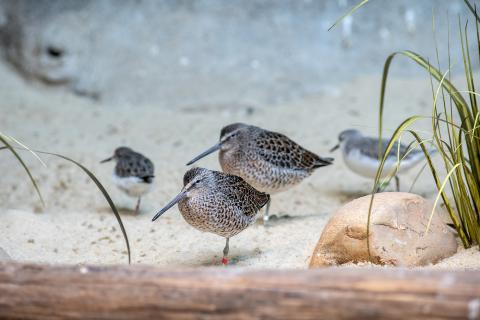Allen's swamp monkeys are small, stout animals with brown and gray-green fur and long tails. These highly social primates live in central Africa's swamp forests where they spend most of their time in trees.
Physical Description
Allen's swamp monkeys are small and stout. Their fur is brown, gray and green and grows longer around the neck and shoulders than on the rest of the body. Their tails are generally longer than their bodies.
Size
Adults may reach 18 inches (45.7 centimeters) in body length with tails over 19 inches (48.2 centimeters) in length. Males are noticeably larger than females and can exceed 13 pounds (5.9 kilograms), while females are closer to 7.5 pounds (3.4 kilograms).
Native Habitat
Allen's swamp monkeys are native to central Africa and are primarily concentrated in the lowland forests of the Congo basin, which includes Cameroon, Congo and Democratic Republic of the Congo. As their name suggests, Allen's swamp monkeys inhabit swamp forests. Water is central to their habitat, and groups may even choose to sleep near bodies of water.
Lifespan
The life span of the Allen's swamp monkey is estimated to be about 28 years.
Communication
To communicate with members of their troop, Allen's swamp monkeys use gestures and calls. Their vocalizations include warning chirps, deep croaks and grunts.
Food/Eating Habits
Allen's swamp monkeys are omnivores and eat a variety of fruits, seeds, insects, fish, shrimp, snails, small invertebrates and leaves. They forage on the ground and in shallow water.
At the Smithsonian's National Zoo, Allen's swamp monkeys receive a diet consisting of a complete primate biscuit supplemented with vegetables, greens and fruits, and a small amount of root vegetables.
Sleep Habits
Allen's swamp monkeys are diurnal, meaning they are active during the day.
Social Structure
A highly social primate, the swamp monkey lives in groups of 40 or more individuals. Like many other primate species, the swamp monkey practices social grooming, strengthening troop bonds by grooming each other. Smaller groups break off to forage. Though they are largely arboreal, spending much of their time in the trees, the semi-terrestrial monkeys will come to the ground to forage.
Reproduction and Development
Allen's swamp monkeys live in social groups with multiple males and females. Females give birth to a single young or, very rarely, twins after a five to six month gestation period. The females are thought to be the primary care givers. Young are typically weaned after about three months and are extremely active. Births of Allen's swamp monkeys have been recorded throughout the year.
Conservation Efforts
The Allen's swamp monkey is considered to be a species of least concern, though it is protected by the Convention on the International Trade in Endangered Species and the African Convention on the Conservation of Nature and Natural Resources.
The primary threats to the monkeys include hunting for bushmeat, killing in retaliation for crop raids and collection for the pet trade. IUCN states a need for further studies on the impact of hunting on the population.
Help this Species
- Choose your pets wisely, and do your research before bringing an animal home. Exotic animals don’t always make great pets. Many require special care and live for a long time. Tropical reptiles and small mammals are often traded internationally and may be victims of the illegal pet trade. Never release animals that have been kept as pets into the wild.
- Share the story of this animal with others. Simply raising awareness about this species can contribute to its overall protection.
Meet the Animals
The Zoo is home to four Allen's swamp monkeys. The females are named Zawadi and Layla, and the males are named Bakari and Edgar.
Animal News

Leaf-tailed Gecko Treated for Skin Cancer With Chemotherapy




